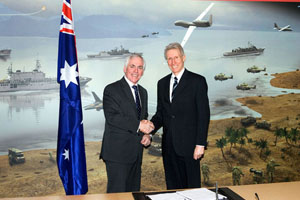Defence turns to SOA for better battles

The Defence Science and Technology Organisation (DSTO) is testing a service-oriented architecture (SOA)-based system to relay information from various intelligence sources and create a detailed image of a battlefield.

Ron Fisher, MD Raytheon Australia (left) and Dr Ian Sare, DSTO acting chief defence scientist DSTO, after signing the agreement
(Credit: DSTO)
The Distributed Common Ground System (DCGS), developed by defence systems company Raytheon, is designed to combine intelligence — such as data from air- or ground-based sensors — into a single system, allowing defence analysts to better grasp a battle situation.
"In a battlefield environment, you're pulling together various types of [intelligence] from various sources," said Dr Duncan Craig, DSTO research leader information integration.
The information — which could be data from ground- or air-based sensors, imagery, or signal information — flows into a central repository where it can be analysed.
"Defence organisations tend to treat this [intelligence] feed in a stove-pipe fashion," said Craig, with information from different sources being handled by different systems. As a result, analysts have to operate many types of software to access the information they need.
The Raytheon backbone integrates the different data sources, while software applications running on the backbone display the gathered information and analyse it for operators to exploit.
Some surveillance sources are unique to Australia, Craig said, including over the horizon radar so the DSTO team will need to tweak the Raytheon system to accommodate such eccentricities.
The test bed will be set up in Edinburgh, Victoria. Once the backbone is set up and some example software applications are run on it, DSTO will wait for the Department of Defence to decide if such a system would be of use to the Australian military.
"At this point we're focusing just on the Raytheon product as an example," Craig said. "There are other flavours of DCGS integrated backbones being produced around the world."